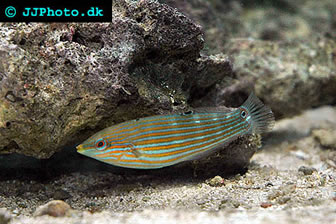Neon Wrasse
Halichoeres melanurus
Common name: Neon Wrasse, Yellowhead wrasse
Scientific name: Halichoeres garnoti
Max size: 7 in / 18 cm (usually smaller)
pH: 8.1-8.4
Salinity: 1.020-1.025
Temperature: 72-78ºF (22-26°C)
The Neon wrasse is a relatively new species in the trade and is quickly becoming popular. It is very beautiful and quite easy to care for. It might not be an ideal beginner fish, but it is suitable for intermediate marine fish keepers. Sometimes emaciated fish are offered for sale in the trade and it can be very hard to nurse these specimens back to health, especially if they have lost their appetite. It is therefore always recommended to ask the fish store to feed the fish so that you can see them eat before you make a purchase. A hale and hearty Neon wrasse has a healthy appetite.
Acclimatize the fish for at least 4 hours before releasing it into your aquarium. Neon wrasses often spend a lot of time burrowed into the sand until they feel at home in your tank. The Neon wrasse likes to dig itself down into the bottom now and then even when it has accustomed itself to the aquarium so don't be alarmed if you don't see it every time you check your fish. It will always sleep buried in the sand.
Juvenile Neon wrasses look very different compared to adult specimens. Juveniles have a yellow body with a blue horizontal line running across the middle. Adult males have a blue body white a yellow field on the front part. The lower part of the posterior is soft purple. Females are less colorful.
In the wild, the Neon wrasse is usually seen living in small harem groups with one male and several females. I recommend keeping them under similar conditions in your tank as well but you can keep this species in pairs or as a single specimen as well if you want to. The Neon wrasse is relatively peaceful and can be kept with other small and midsized friendly fish species, such as fairy wrasses and gobies. Do not keep with triggers or other aggressive species. This species is generally considered reef safe but may sometimes eat small shrimps so if you keep small shrimps in your reef setup this might not be the best species for your tank.
The Neon wrasse, or Yellowhead wrasse as it is also called, originates in the western part of the Atlantic. It can be found in the waters of Florida,United States, in the entire Caribbean Sea, and down along the South American coast to south-eastern Brazil.
Neon Wrasse care and aquarium setup:
Neon wrasses are best kept in aquariums no smaller than 50 gallon / 200 L. There should also be a lot of room to swim in. The most important thing when decorating the aquarium for the Neon wrasse is to create an environment in which the fish feels secure to avoid stress. When you decorate, there are two important things to think about:
- This species, like all wrasses, want a deep small grained sand bed in which it can bury itself if it wants to hide. The sand bed should be at least 3 inches / 7 centimetres thick.
- The other thing to think about is to create enough caves and hiding places in the tank. At least some of the caves should offer a shaded place for the fish to rest in.
This species do well in "fish only" tanks, "FOWLR" tanks, and reef set-ups. They prefer a well circulated well lit aquarium.
Ideal conditions for Neon wrasse is pH 8.1-8.4, salinity 1.020-1.025, and temperature 72-78ºF (22-26°C).
Feeding Neon Wrasse
The Neon wrasses are easy to feed as they will accept most food types including marine pellets and flake food. It is important to give them a varied diet and they should not be fed exclusively flake food/pellets. A good diet might be based around pellets that is complemented with vitamin enriched brine shrimp, live food and chopped up sea food. Feed your Neon wrasses 3-4 times a day and make sure they get enough food.
Breeding Neon Wrasse
The Neon wrasse is a hermaphrodite and all specimens are born as females. The dominant female will develop into a male if there isn't a male in the area. Sometimes subordinate females can develop into subordinate males. If the dominant male then dies, one of the subordinate males becomes dominant male and no female has to turn into a male. A Neon wrasse female can develop into a working male in 10-14 days. They sometimes spawn in large public aquariums and it is possible that very large high aquariums are required to allow this species to complete its courting and spawning behavior. The Neon wrasse is an egg-laying species.
Wrasse Articles:
Bird Wrasse – Gomphosus varius
Dragon Wrasse - Novaculichthys taeniourus
Harliquin Tuskfish – Coerodon fasciatus
Hogfish - Information about Hogfish
Ornate Wrasse – Halichoeres ornatissimus
Queen Coris – Coris frerei
Radient Wrasse – Halichoeres iridis
Spanish Hogfish – Bodianus rufus
Striated Wrasse – Pseudocheilinus evanidus
Yellow Coris – Halichoeres chrysus
Line Wrasses:
Fourline Wrasse – Pseudocheilinus tetrataenia
Sixline Wrasse – Pseudocheilinus hexataenia
Eightline Wrasse – Pseudocheilinus octotaenia
Fairy Wrasses:
Exquisite Fairy Wrasse – Cirrhilabrus exquisitus
Lubbock's Fairy Wrasse – Cirrhilabrus lubbocki
Scott's Fairy Wrasse – Cirrhilabrus scottorum
Solar Fairy Wrasse – Cirrhilabrus solorensis
Flasher Wrasses:
Carpenter's Flasher Wrasse – Paracheilinus carpenteri
Dot-and-Dash Flasher Wrasse – Paracheilinus lineopunctatus
Filamented Flasher Wrasse – Paracheilinus filamentosus
McCosker's Flasher Wrasse – Paracheilinus mccoskeri

